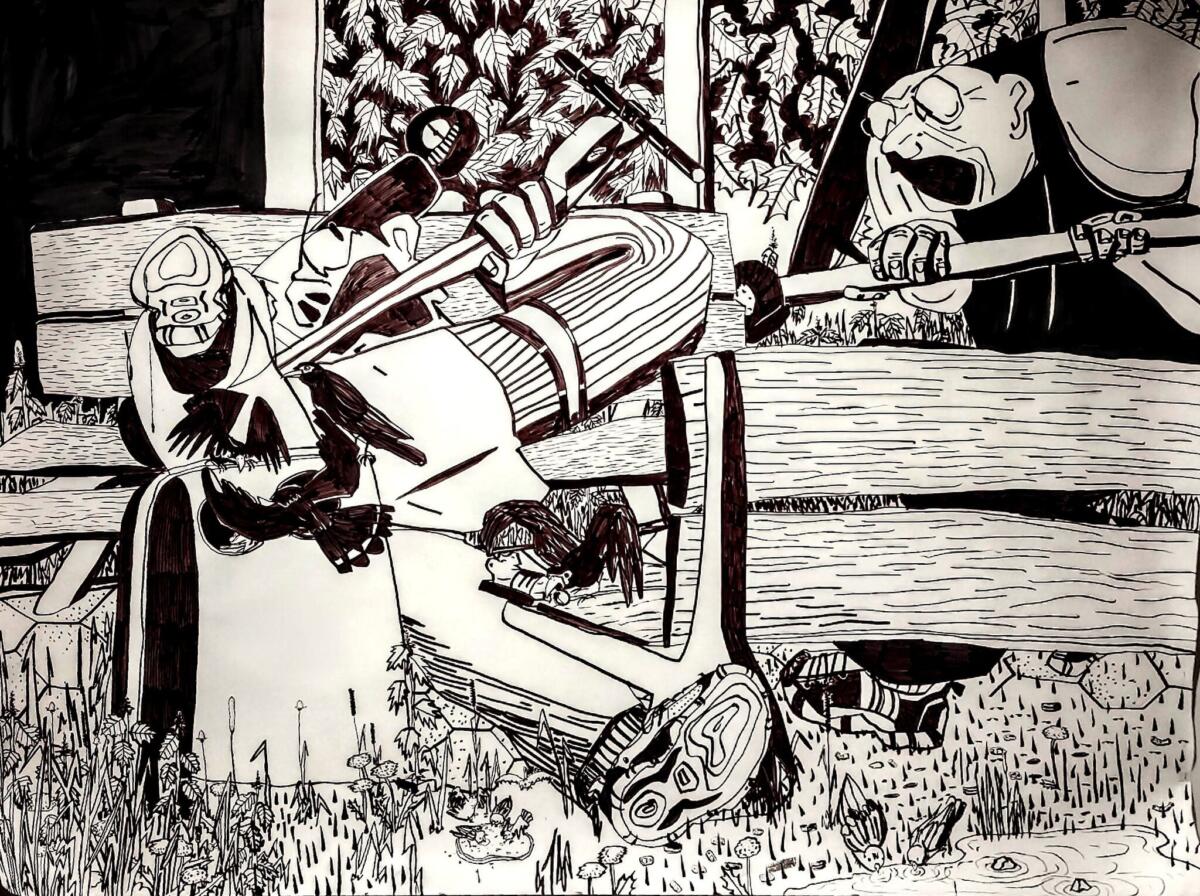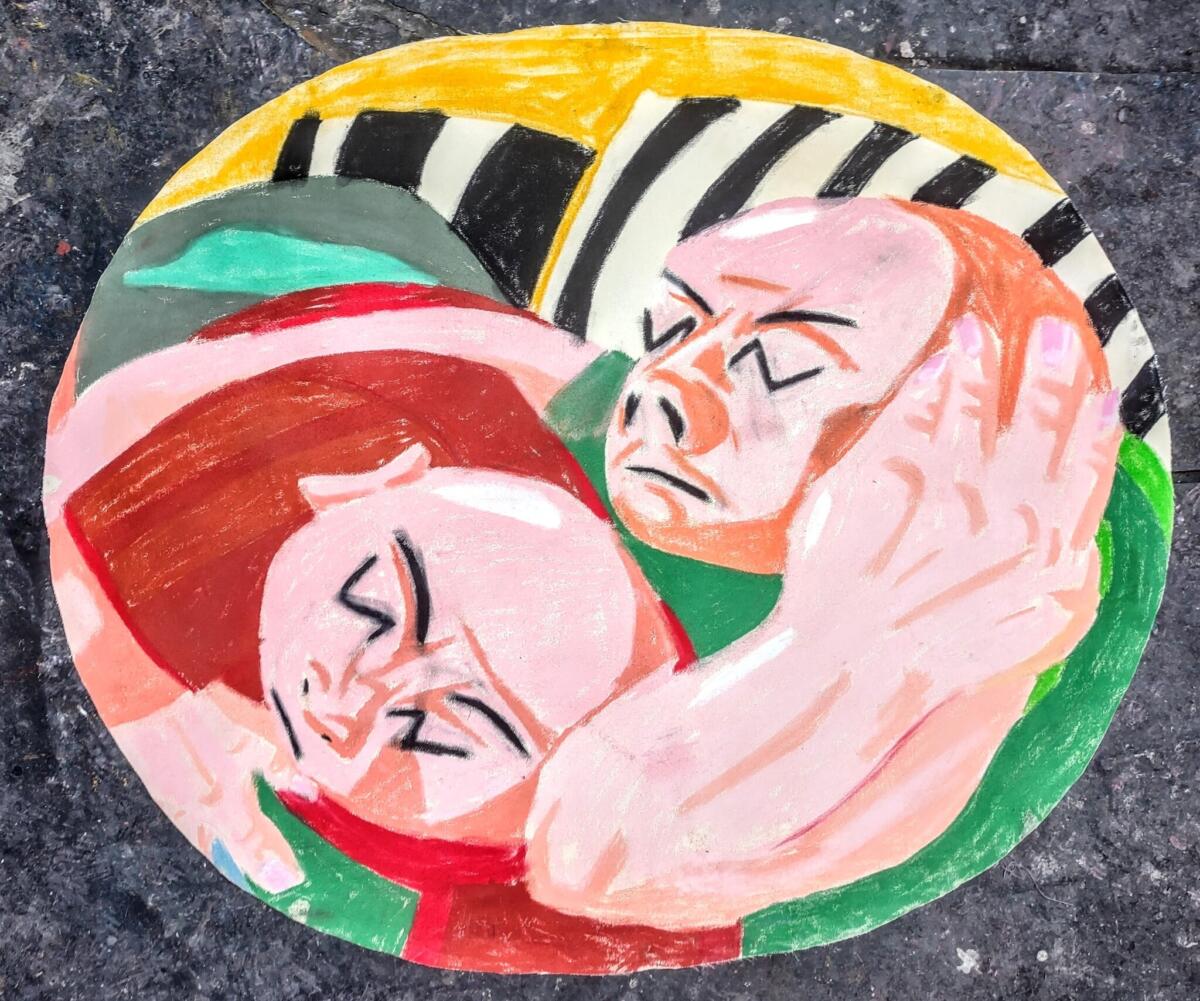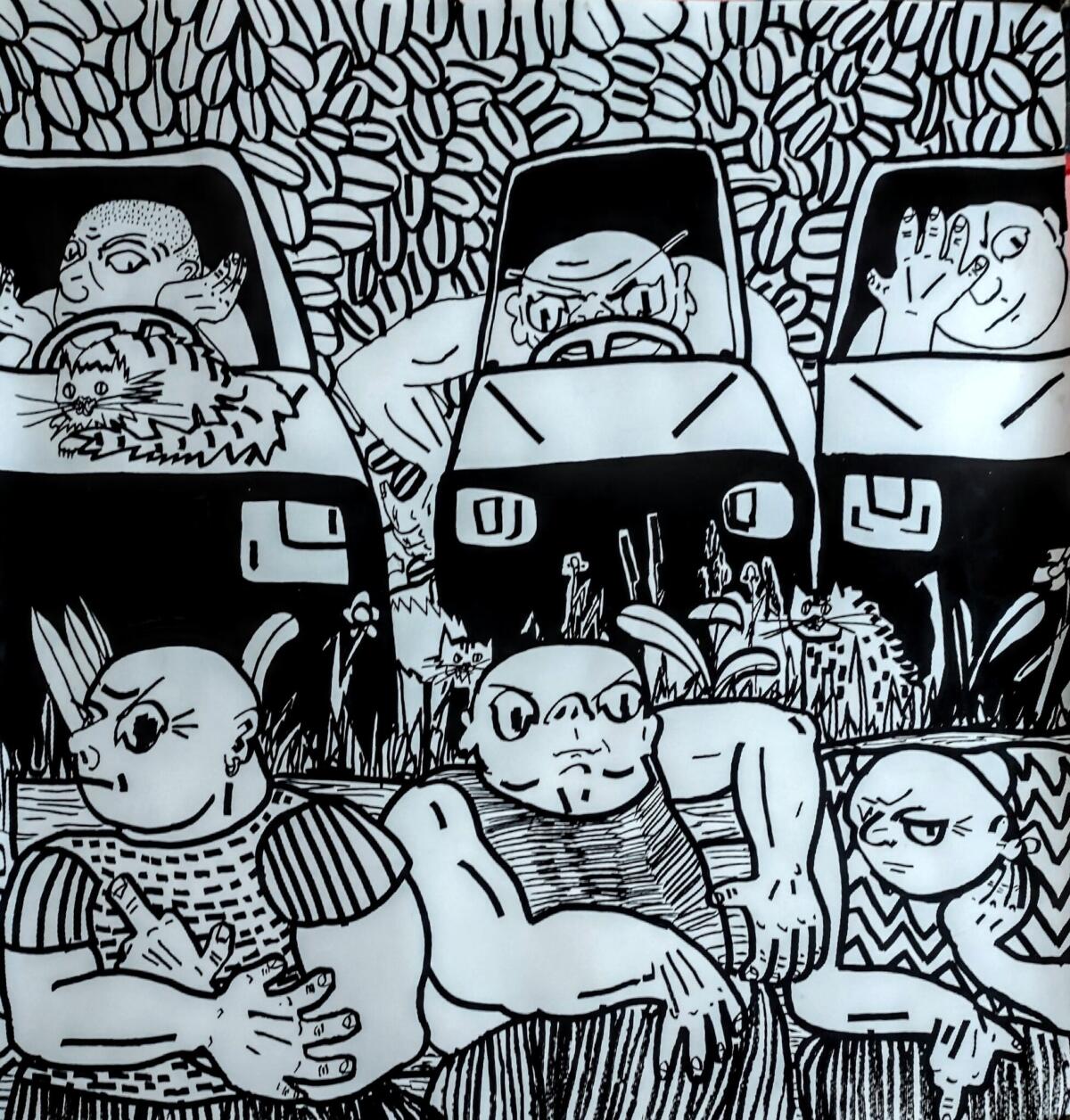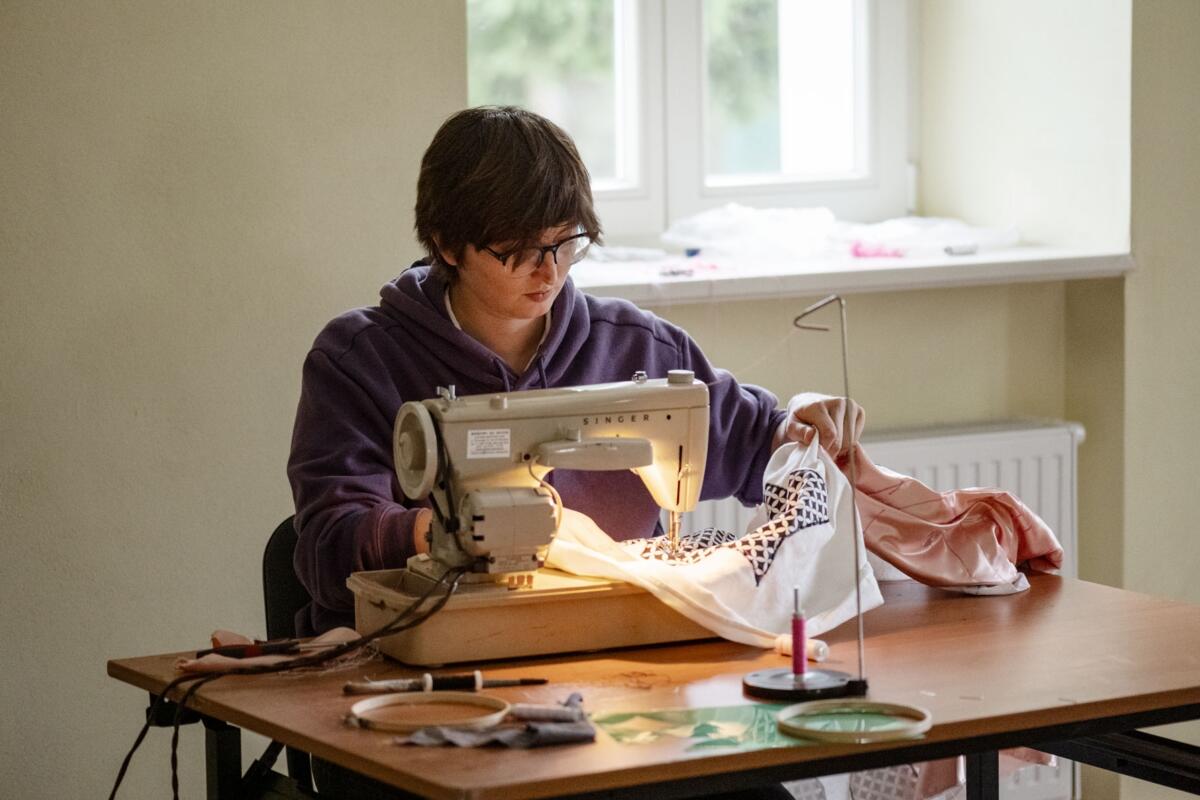
Joanna Sokołowska: Your residency in Krzyżowa coincided with the end of your studies in Painting at the Eugeniusz Geppert Academy of Fine Arts and Design in Wrocław. From our conversations so far, I have realised that a lot of your experience, inspiration, and knowledge of the world comes from the internet, and that you are immersed in the virtual world to the maximum on a daily basis. Why did you decide to study painting and work manually rather than create digital moving pictures, for example?
Daniel Mikulski: I don’t think I made that decision to paint or draw, I just never stopped. That’s how I have expressed myself since I was a child.
And when you went to university, did you feel any change? By going to the Academy of Fine Arts, you decided to study professionally….
I definitely wanted to develop my skills further. It was the only thing that I was able to imagine myself doing; I was just doing it all the time.. Apart from this, I don’t have many other interests.
Apart from your innate impulse to paint and draw, have there been any artistic and cultural practices or people that have been a source of inspiration along your path?
There are things that are visually interesting to me, such as sports clothes from the 90s or colour schemes of toys from the bazaar. I also like the aesthetics of pixel art, the early days of the internet, old computer games such as Super Mario Bros. and Minecraft. And sometimes colour combinations that can be seen in nature.
Have you developed any working methods? What do you start with?
I start by choosing a motif that interests me visually and that has associations with something important to me. For example, birds with ADHD, hands with autism, hugging with cuddling. Then the repetitions are important to me.
Could you elaborate on the repetitions?
I process thoughts and feelings through repetition. It’s a natural way for me to develop the form of my paintings. I have neither stumbled nor consciously chosen it, I do it naturally because I feel like it. Repetition is my way to become familiar and comfortable with the subject, to express my love for that subject. When I find a cool colour, motif or phrase, I become obsessed with it – wear clothes with it, think about it all the time and talk about it with everyone. Then I want to develop or use this motif in a painting. I often make sketches. Sometimes I paint it straight away. I look to see if I like the composition, if I like the colours, if the whole thing evokes the emotions I’m after. And depending on what I notice, I do the next thing. I make changes based on those observations.
I definitely work in rather large series, they typically range from 12 to 72 pieces. When there are figures, I often draw and paint them from my eye level. I further ponder what would change in the meaning, composition or visual layer of the painting if the perspective were changed. And I simply repeat the given motif in a different perspective in the next painting. And so I keep repeating different variations until I simply come up with another motif.
Your works most often refer to emotions, which you also suggest by the titles of your works, for example your series “Tender” or “Aggressive.” Can you share more about the phenomena or emotions that you explore in your process?
The series “Tender” was created during my convalescence after a mastectomy. It was part of my thesis entitled “Transgender aspects in Painting.” After the operation I felt that my body was becoming more expressive, that I had a new relationship with it, that I was better at interacting with other people because of it. At the same time, it was a time of rest, of slowing down, of intimacy. Hence the motif of sleeping, cuddling figures. On the other hand, the drawing annex of the diploma, entitled “Think twice,” refers to functioning in a public space, where there are a lot of people and you don’t know who has what intentions. So it’s about social anxiety, how it affects our relationships, and how it protects us, because actually some people are better to approach than others. But on the other hand, this anxiety can block when it would be better to make contact or react.
There are echoes of great tension in your works, especially stress particular to minority groups. You refer directly to the fear of exclusion in your drawings entitled “To fall off the bike.” What does this title mean?
Death, being erased, being banned from an internet forum. But for me, it also refers to situations of being laughed at, of being excluded as a transgender person.
The body as a medium for experiencing and expressing emotions seems to be foregrounded in your work. In your paintings and drawings it is represented by emotionally charged, distorted or enlarged parts. You also seem to explore non-verbal communication manifested in gestures. In some of your works, such as “Love Diptych for Neurodivergent People,” you focus on relationships and intimacy expressed in the merging of bodies and the qualities of the fluidity of flesh. Your paintings, particularly the soft pastel ones, also exhibit a fleshy appearance, emphasised notably through the prevalence of various shades of pink. Do you consider bodily experiences to be a primary source of knowledge?
Yes, that is the point.
Let’s move on to the works you created in Krzyżowa. What effect does this place and the formula of artist-in-residence have on you?
I enjoyed working there very much. I had access to a large studio, materials, and time. I didn’t have to worry about anything; about shopping, cooking, etc. I realised all my ideas here which I didn’t have the time and space for before.
So tell us about the works you realised here. Let’s start with “Evening Cycle for Neurodiverse People.”
These works are about the trouble of resting and techniques, often non-standard (body positions that allows some level of muscle tension so I don’t forget my body exists, eating certain types of food for a month daily, watching cars, looking at intense lights, biting objects, applying pressure or weight on my body, loud music, etc.) to relax and recuperate.
In the foreground of the paintings are enlarged, expressive, twisted hands, incongruously joined to other body fragments that appear in a schematic, semi-abstract setting. The hands seem to be driven by an unseen force with a life of its own.What significance does this motif have for you?
Hands are the most restless part of my body. I often discover injuries on them that I don’t know how they appeared. Sometimes they seem to me something alien, detached from the body. In my paintings, the body is actually often shown in fragments. I want to show this sense of disconnection.
And how does this relate to the theme of regeneration?
I need to keep my hands busy to calm myself down. For example, playing on my phone. I keep myself busy with various techniques, but also with basic reflexes or compulsions.



You realised some of your newly created works using a patchwork technique for the first time. Most of them have a form and composition akin to your paintings, in that they are patchwork but stretched like a canvas. However you have also crafted a spatial patchwork in the form of a body pillow.What made you want to try to work with the patchwork technique?
It is very pleasant. I got a sewing machine, it was a gift from my friend Marlena Kruk. It was nice to use it, so I got super excited and started using it a lot. I noticed that patchwork looks amazing, I can do patchwork without access to the studio. Sewing also allows you to create soft, gentle spatial objects. It works well with those of my cycles that are about love and sexuality (like the body pillow I made). I like going to shops and choosing fabrics. I also really liked working on the sewing machine. Well, and it’s more durable than pastels. You can wash the fabric if it gets dirty, touch it, wrap it. It’s a very tactile material.
And did you take into account the gendered aspect encoded in the history of working in fabric?
Yes. For me, things associated with feminine activities and in general ways of functioning are cooler, smarter, better conceived and more useful. I also like communicating online with a community of people who are associated with women’s activities. It’s a safer space than forums influenced by masculine culture of rivalry and toughness. When I ask on a forum for advice related to crocheting or sewing I get an answer, not like, for example, in “Elektroda” [an online electronics forum], where there is a lot of aggression and judging.
Apart from your individual work, part of your residency was working with young people participating in the foundation’s exchange programmes. What was that experience like for you?
It was very tough. I’m terrified of teenagers! I didn’t work through this, I failed 100% and almost cried. I felt like I was in high school again but in high school I was on individual learning so I didn’t have to talk to “normal” teenagers. My approach was not to make any harm to them while also not further damaging myself. I had a plan, but I was panicked. My trauma was triggered when I entered room full of teenagers.


About the Konrad and Paweł Jarodzki International Artists-in-Residence Programme.
Imprint
| Artist | Daniel Mikulski |
| Place / venue | The international Konrad and Paweł Jarodzki artist-in-residence programme at the Krzyżowa Foundation for Mutual Understanding in Europe |
| Dates | 2023 |
| Index | Daniel Mikulski Joanna Sokołowska Konrad Jarodzki Krzyżowa Foundation for Mutual Understanding in Europe Paweł Jarodzki The international Konrad and Paweł Jarodzki artist-in-residence programme |



